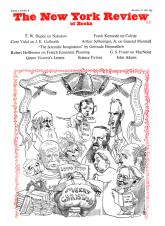Dr. Finley has managed to include a great deal in this compact book. He has given a general account, part exposition, part narrative, of the “classical” Greeks from the heroic age down to their absorption into the Roman Empire, the rise of the polis or “city state,” something of its variations in politics, religion, literature, philosophy, science, and the arts. There is necessarily some skimping. Through the middle of the book the reader’s attention is fixed almost exclusively on Athens. Since for the fifth century, at least, we know more about Athens than about all the rest of the Greek states put together, writers of general introductions to Greek life tend to give the beginner an impression that Athens was the only state where anything worth while was going on. Dr. Finley is not always free from this fault. “This is a personal analysis,” he says in his preface. Opinions are boldly and trenchantly stated. Here is an example (p. 31):
…the temple was a house for a god, not a place of worship. The rituals by which one gave thanks to the Olympic gods or pleaded with them or appeased them required no temple but an altar; and altars existed everywhere, in the homes and fields, in the places of assembly, outside the temples—everywhere, that is, but not inside a temple
The chapter on Greek science and technology, the latter conspicuous by its failure, is brilliant, perhaps the best in the book. Of course, in so brief a discussion of vast issues, this or that reader will find cause for disagreement. A simple case is on page 16: “he [Hesiod] tells us all about himself.” He does not, we don’t even know whether he was married. “The law is king” (p. 41) is not a good rendering of nomos ho panton basileus (if that is what it is meant to represent; sometimes the absence of specific reference is irritating). In general, Dr. Finley’s concept of nomos seems to me too narrow; the nomoi of the Greeks include not only their laws but the way they dressed and dined and the food they ate, the way they married and the way they buried, their mutual conduct within the family, and the gods they worshipped and how they did it. Here, despite their “particularism,” there is a remarkable degree of pan-Hellenic homogeneity which I think Dr. Finley underestimates (p. 35). Many conclusions are bluntly stated rather than argued, but despite my not infrequent personal disagreements, I find this book more than stimulating. It is enlightening.
This Issue
December 12, 1963



